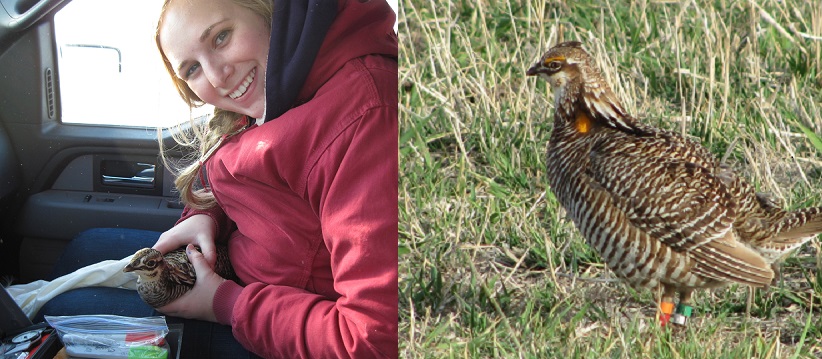
Why did the chicken cross the road?
While the punchline to that age-old joke may most commonly be, "to get to the other side," – what if the road were more than 30 miles wide?
"Prairie chickens do fly, but they only fly for short periods and close to the ground," said Jocelyn Olney, a natural resource sciences graduate student.
Olney was part of a team of researchers from the School of Natural Resources who banded 70 prairie chickens in the Sandhills last spring. They were trapped using non-baited, walk-in funnel traps near the lek grounds, which are areas on the land where males gather in the spring to dance and attract females for breeding.
"We trapped at 13 leks within 25 km of the Ainsworth, Neb., wind farm," Olney said. "Leks were distributed evenly along a 25 km gradient from the wind farm in order to trap prairie chickens at varying distances from the wind farm."
Once a prairie chicken was trapped, researchers outfitted the bird with three color bands and one metal ID band in a unique combination to allow for easy identification of birds from a distance. Females were fitted with either a very high frequency (VHF) radio transmitter collar or a rump-mounted satellite tag.
Prairie chickens were then released at the lek of capture.
"Banding has several advantages for understanding the life history of prairie chickens," Olney said. "One of the most interesting questions we can answer is how far prairie chickens move during different seasons. With the help of radio and satellite telemetry, we were able to track females throughout the breeding, nesting and brood-rearing periods."
The ID bands are important because if a prairie chicken is predated or hunted, researchers can tell the ID of the individual bird because of its bands. They can then assess how far that bird traveled from its lek of capture and previous sites, and whether their movements were influenced by the presence of the wind farm in Ainsworth.
"The banding process helps us get a better picture of the survival of adults both near and far from the wind farm," Olney said.
Prairie chickens typically stay within five miles of their lek of capture during the breeding, nesting and brood-rearing seasons. In the fall, however, researchers were alerted to something unusual.
"We recently discovered that a hunter recovered a prairie chicken over 30 miles from its lek of capture," Olney said.
Although this prairie chicken was tagged with a VHF radio collar, researchers never found her during the spring or summer breeding, nesting and brood-rearing seasons, which may indicate that she traveled the distance during the spring or summer.
"Most people think these birds stay put all year," said Larkin Powell, professor and director of the Great Plains Cooperative Ecosystem Studies Unit.
Olney said that it's unknown exactly when the prairie chicken made her 30-mile trek.
"It's possible that she traveled this distance during the fall, which would be less unexpected, but still quite the journey for a prairie chicken that is not built for traveling long distances," she said.
Prairie chickens were historically found across 20 states and four Canadian provinces, but due to land conversion to agriculture and subsequent habitat loss over the past 80 years, prairie chicken range has been significantly reduced.
Fortunately, Nebraska has the largest prairie chicken population in the United States – although you're unlikely to see one cross the road anytime soon.
"One misconception is that prairie chickens migrate, which is not true," Olney said. "So traveling long distances is quite taxing for them in terms of energy expenditure."
— Mekita Rivas, UNL School of Natural Resources
More details at: http://go.unl.edu/nw4z